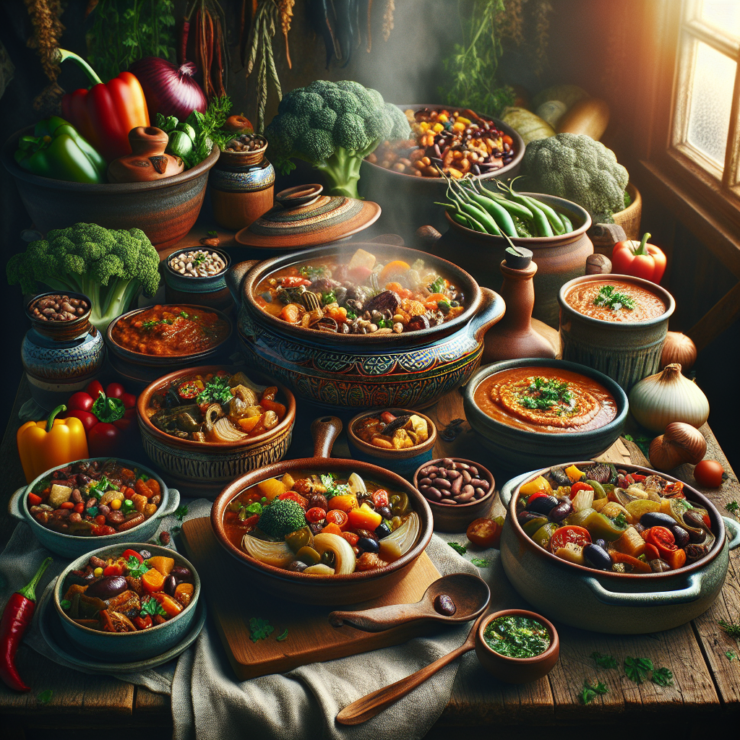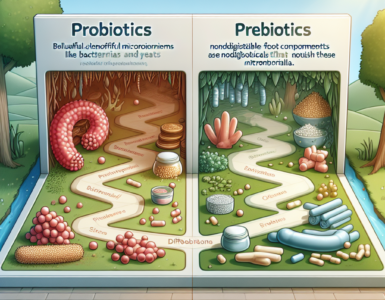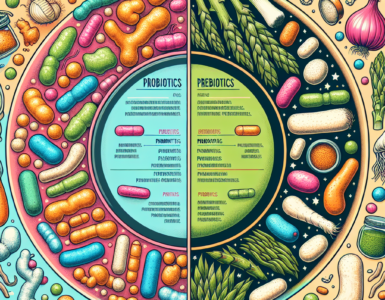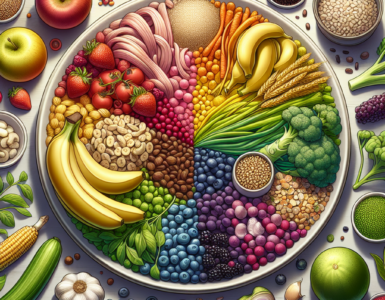The Rise of One-Pot Vegan Meals
One-pot meals have become a cornerstone in the kitchens of those who prioritize convenience without compromising on nutrition. The intersection of one-pot cooking and veganism is a trend that is growing rapidly due to its alignment with modern lifestyle needs.
The Appeal of One-Pot Cooking
One-pot cooking is revered for its simplicity and convenience. The method involves using a single pot to prepare an entire meal, which translates to less time spent on cooking and cleaning up. This efficient style of cooking is particularly attractive to busy individuals who are looking to minimize kitchen work while still enjoying a homemade meal.
The simplicity of one-pot meals also encourages culinary creativity, as cooks can easily experiment with a variety of ingredients without the need for complex cooking techniques. Additionally, one-pot meals are perfect for meal prepping, as they can be cooked in large batches and stored for later consumption.
| Benefits | Description |
|---|---|
| Time-saving | Less preparation and cooking time |
| Energy-efficient | Single pot reduces energy usage |
| Minimizes cleanup | Only one pot to clean |
| Portability | Easy to transport and reheat |
Why Veganism is Gaining Popularity
Veganism is on the rise for a multitude of reasons. From a health perspective, a plant-based diet is linked to numerous benefits such as lower risks of heart disease, hypertension, type 2 diabetes, and certain types of cancer. Environmentally, veganism supports sustainability by reducing the carbon footprint associated with animal farming and mitigating the impact on natural resources.
Ethical considerations also play a significant role in the shift towards veganism. Many individuals choose to adopt a vegan lifestyle to stand against animal cruelty and the exploitation of animals for food.
The integration of veganism into mainstream culture has been facilitated by the availability of diverse plant-based ingredients, making it easier than ever to enjoy a varied and satisfying vegan diet.
| Reasons for Popularity | Impact |
|---|---|
| Health benefits | Reduced risk of chronic diseases |
| Environmental sustainability | Lower carbon footprint |
| Ethical considerations | Animal welfare |
One-pot vegan meals represent the convergence of these two movements, offering a practical solution for those seeking to lead a healthier, more sustainable, and ethically conscious lifestyle. With their ease of preparation and potential for nutrient-rich meals, it’s clear why these dishes are becoming staples in the diets of many.
Benefits of One-Pot Vegan Meals
One-pot vegan meals are a testament to the fact that simplicity does not have to compromise on nutrition or flavor. As more individuals seek out convenient and healthful eating options, these meals are gaining traction as a practical solution.
Nutritional Advantages
A well-planned one-pot vegan meal can pack a dense nutritional punch. These meals often incorporate a variety of vegetables, legumes, whole grains, and nuts, which collectively contribute a wide spectrum of essential vitamins, minerals, fiber, and antioxidants. Here’s a glance at the potential nutritional composition of a one-pot vegan meal:
| Nutrient | Vegan Ingredient Sources |
|---|---|
| Protein | Chickpeas, Lentils, Tofu |
| Vitamins | Kale, Broccoli, Bell Peppers |
| Minerals | Quinoa, Black Beans, Almonds |
| Fiber | Brown Rice, Barley, Sweet Potatoes |
| Antioxidants | Tomatoes, Spinach, Berries |
Time and Energy Efficiency
One of the most appealing aspects of one-pot vegan meals is the minimal time commitment. Instead of juggling multiple pots and pans, one can create a wholesome meal using a single cooking vessel. This streamlined cooking method saves on both preparation and cooking time, making it an ideal choice for busy lifestyles.
Moreover, one-pot cooking is energy efficient. With only one burner or oven setting in use, less energy is consumed, which is both cost-effective and environmentally friendly.
Simplification of the Cooking Process
The simplification of the cooking process is a major benefit that cannot be overstated. Not only does it make the act of cooking less daunting for novices, but it also reduces the cleanup required post-meal. With fewer dishes to wash, individuals can enjoy their dining experience without the looming task of a cluttered kitchen.
Additionally, one-pot cooking encourages creativity in the kitchen. Without the need for elaborate techniques or equipment, individuals can experiment with various ingredients and flavors to create nutritious and satisfying meals. This simplicity is what makes one-pot vegan meals a staple for those who wish to maintain a plant-based diet without the fuss.
Key Ingredients in One-Pot Vegan Meals
Creating delicious and nutritious one-pot vegan meals starts with a well-stocked kitchen. The right combination of pantry staples, fresh produce, and protein sources can make meal preparation both simple and satisfying.
Staples of a Plant-Based Pantry
When it comes to one-pot vegan cooking, certain pantry items are indispensable. These staples not only provide a solid foundation for a variety of dishes but also contribute significantly to the flavor and nutritional profile of the meals.
- Grains and legumes: Quinoa, brown rice, lentils, and chickpeas are versatile and provide the necessary carbohydrates and proteins.
- Nuts and seeds: Almonds, walnuts, chia seeds, and flaxseeds add crunch and nutrients.
- Oils and vinegars: Olive oil, coconut oil, and apple cider vinegar are essential for cooking and dressing.
- Herbs and spices: A selection of dried herbs and spices like basil, cumin, and turmeric can enhance any dish.
- Condiments and sauces: Soy sauce, tahini, and nutritional yeast offer depth and umami flavor.
Fresh Produce Essentials
Fresh vegetables and fruits are the heart of vegan cooking. They supply essential vitamins, minerals, and fiber, all of which are important for a balanced diet.
- Leafy greens: Spinach, kale, and arugula are rich in iron and vitamins.
- Colorful vegetables: Bell peppers, carrots, and beets add vibrancy and antioxidants.
- Fruits: Tomatoes, avocados, and lemons provide freshness and tang.
- Root vegetables: Sweet potatoes and onions offer heartiness and grounding flavors.
Protein Sources for Vegans
Protein is a crucial component of any meal, and there are plenty of plant-based options that fit perfectly into one-pot dishes. These protein sources ensure that the meals are filling and nutritionally complete.
- Legumes: Beans and lentils are not only rich in protein but also fiber and iron.
- Tofu and tempeh: These soy-based proteins are adaptable to a variety of flavors and cooking methods.
- Plant-based proteins: Products like textured vegetable protein (TVP) and seitan can mimic the texture of meat and are protein-rich.
| Protein Source | Protein per 100g |
|---|---|
| Lentils | 9g |
| Chickpeas | 19g |
| Black Beans | 21g |
| Tofu | 8g |
| Tempeh | 19g |
| TVP | 51g |
| Seitan | 75g |
Incorporating these key ingredients into one-pot vegan meals not only simplifies the cooking process but also ensures that each dish is a harmonious blend of flavors and nutrients. With the right components on hand, creating a variety of satisfying vegan meals becomes effortless and enjoyable.
Planning Your One-Pot Vegan Meals
Creating one-pot vegan meals requires a bit of planning to ensure that the dishes are not only quick and easy to prepare but also nutritionally balanced and flavorful. The following sections guide you through the key considerations for meal planning.
Balancing Macronutrients
A balanced meal includes a good mix of carbohydrates, proteins, and fats. For vegan meals, this often involves a combination of different plant-based ingredients to ensure a well-rounded nutrient profile.
| Macronutrient | Plant-Based Sources |
|---|---|
| Carbohydrates | Whole grains, such as brown rice, quinoa, and barley |
| Proteins | Legumes, nuts, seeds, and tofu |
| Fats | Avocados, olive oil, nuts, and seeds |
When planning your one-pot meals, aim to include at least one source from each category to create a balanced dish. For instance, a chili could include beans for protein, tomatoes for carbohydrates, and avocado oil for fats.
Flavor Pairing in Vegan Cooking
Flavor pairing is crucial in vegan cooking to create dishes that are satisfying and enjoyable. Using a variety of herbs, spices, and seasonings can elevate the taste of simple ingredients. Here are some classic combinations that work well in one-pot dishes:
| Cuisine | Herbs & Spices |
|---|---|
| Italian | Basil, oregano, garlic, and fennel |
| Mexican | Cumin, chili powder, coriander, and paprika |
| Indian | Turmeric, garam masala, cumin, and coriander |
When selecting flavors, consider the base ingredients of your dish and choose spices that will complement and enhance the natural flavors of the produce and grains.
Time-Saving Tips for Meal Preparation
One-pot vegan meals are all about efficiency. To save time, consider the following tips:
- Prep in Advance: Chop vegetables and measure out spices ahead of time.
- Use Canned or Frozen Produce: These can be just as nutritious as fresh produce and save on prep time.
- Batch Cooking: Make larger quantities of your one-pot dish and store portions for future meals.
- Simplify Recipes: Opt for recipes with fewer ingredients and steps.
By incorporating these strategies into your meal planning, you can enjoy nutritious and delicious one-pot vegan meals without spending hours in the kitchen.
Popular Types of One-Pot Vegan Meals
One-pot vegan meals are a boon for those who are pressed for time yet committed to sustainable eating and nutritious plant-based diets. They are simple, require minimal cleanup, and can be highly nutritious. Below we explore some of the most popular one-pot vegan dishes that cater to a variety of tastes and preferences.
Soups and Stews
Soups and stews are the quintessence of one-pot cooking, offering endless variety and heartiness to satisfy any palate. A well-crafted vegan soup or stew combines a rich base, an assortment of vegetables, and a protein source such as beans or lentils. These dishes are not only comforting but also packed with essential nutrients.
| Soup/Stew Type | Key Ingredients | Protein Source |
|---|---|---|
| Vegetable Soup | Broth, Tomatoes, Green Beans, Carrots | Chickpeas |
| Lentil Stew | Lentils, Onions, Celery, Garlic | Lentils |
| Minestrone | Vegetable Stock, Zucchini, Pasta, Kidney Beans | White Beans |
Curries and Chilis
Curries and chilis bring a burst of flavors to the one-pot meal scene, with spices and herbs taking center stage. Vegan curries often incorporate coconut milk for creaminess, while chilis rely on beans and textured vegetable protein for body and heartiness. These dishes are perfect for meal prep as their flavors deepen over time.
| Curry/Chili Type | Key Ingredients | Protein Source |
|---|---|---|
| Chickpea Curry | Chickpeas, Coconut Milk, Tomatoes, Spinach | Chickpeas |
| Black Bean Chili | Black Beans, Bell Peppers, Corn, Tomatoes | Black Beans |
| Tofu Curry | Tofu, Peas, Curry Powder, Coconut Milk | Tofu |
Pasta and Noodles
Pasta and noodles are staples in the realm of one-pot vegan cuisine. They offer a foundation for a multitude of flavors and can be combined with a colorful mix of vegetables. Whole grain or legume-based pastas provide an added protein punch, making these dishes both satisfying and nutritious.
| Pasta/Noodle Type | Key Ingredients | Protein Source |
|---|---|---|
| Vegan Spaghetti Bolognese | Whole Wheat Spaghetti, Lentils, Tomato Sauce | Lentils |
| Peanut Noodles | Rice Noodles, Broccoli, Carrots, Peanut Sauce | Edamame |
| Veggie Mac & ‘Cheese’ | Macaroni, Nutritional Yeast, Cashews, Peas | Cashews |
These popular one-pot vegan meal types are just a starting point for those seeking efficiency and nutrition in their diet. They demonstrate the versatility of vegan cooking and how simple ingredients can be transformed into satisfying meals. Each dish can be customized to cater to individual tastes and nutritional needs, making them a staple for anyone leading a fast-paced yet health-conscious lifestyle.
Cooking Techniques for One-Pot Meals
One-pot vegan meals are not just about simplicity and convenience; they also require specific cooking techniques to maximize flavor and preserve nutrients. Understanding these methods is vital for creating delicious and satisfying dishes.
Sautéing and Simmering Basics
Sautéing involves cooking ingredients quickly at a high temperature with a small amount of oil or fat in a large pot or pan. This technique is excellent for developing a depth of flavor by browning the ingredients, such as onions, garlic, and spices, before adding other components of the meal.
Once the sautéing is complete, simmering comes into play. This low-heat, slow-cooking method allows flavors to meld and ingredients to cook thoroughly without becoming overcooked. To simmer effectively, one should cover the pot after adding liquids, such as water, broth, or canned tomatoes, and let the ingredients cook at a gentle bubble.
| Technique | Heat Level | Cooking Time | Purpose |
|---|---|---|---|
| Sautéing | High | Short | Flavor development |
| Simmering | Low | Longer | Melding flavors |
Mastering the Art of Steaming
Steaming is a gentle cooking method that is perfect for preserving the nutritional content of vegetables, which are a cornerstone of one-pot vegan meals. To steam within a one-pot context, one can add a small amount of water to the pot, insert a steamer basket with vegetables, and cover with a lid.
This method cooks the vegetables through the steam produced by the boiling water, ensuring they remain vibrant and retain most of their nutrients. To master steaming, it’s crucial to monitor the cooking time closely as over-steaming can lead to mushy textures.
The Low-Down on Braising Vegetables
Braising is a technique that combines both dry and moist heat cooking. One begins by sautéing the vegetables at a high temperature. Once they have a nice sear, liquid is added, and the heat is reduced. The pot is then covered, allowing the vegetables to simmer and braise until tender.
This method is ideal for tougher vegetables that benefit from longer cooking times to break down their fibers. Braising imparts a rich flavor to the ingredients and can make the centerpiece of a one-pot vegan meal.
| Technique | Initial Heat | Liquid Added | Result |
|---|---|---|---|
| Braising | High | Yes | Tender, flavorful vegetables |
By employing these cooking techniques, one can ensure that their one-pot vegan meals are not only quick and easy to prepare but also rich in flavor and nutritional value. Whether sautéing, simmering, steaming, or braising, each method contributes to the creation of delicious and wholesome vegan dishes.
Creative Vegan One-Pot Meal Ideas
Creating delectable vegan meals doesn’t have to be time-consuming or complex. These one-pot vegan meal ideas combine nutrition, flavor, and simplicity, perfect for busy individuals who value both their time and their health.
Hearty One-Pot Vegan Chili
A robust and flavorful chili can be the centerpiece of a fulfilling vegan meal. This one-pot wonder is packed with protein and fiber, thanks to an array of beans and lentils, and is seasoned with a rich blend of spices that bring warmth and depth to the dish.
| Ingredient | Quantity |
|---|---|
| Beans (kidney, black, pinto) | 2 cups (cooked) |
| Lentils | 1 cup (cooked) |
| Diced Tomatoes | 1 can (14.5 oz) |
| Bell Peppers | 1 cup (chopped) |
| Onion | 1 medium (diced) |
| Chili Powder | 2 tablespoons |
- Begin by sautéing onions and bell peppers in the pot until they soften.
- Add the cooked beans, lentils, and diced tomatoes to the pot.
- Season with chili powder, cumin, paprika, and oregano to taste.
- Let the chili simmer for at least 20 minutes, allowing the flavors to meld together.
- Serve hot, garnished with fresh cilantro or avocado slices for added freshness and creaminess.
Creamy Coconut Curry
Curry dishes are versatile and can be tailored to include a variety of vegetables and legumes. A creamy coconut curry combines the sweetness of coconut milk with a tapestry of spices for a rich and aromatic experience.
| Ingredient | Quantity |
|---|---|
| Coconut Milk | 1 can (13.5 oz) |
| Chickpeas | 1 cup (cooked) |
| Spinach | 2 cups (fresh) |
| Curry Powder | 1 tablespoon |
| Mixed Vegetables (e.g., carrots, peas) | 2 cups |
- Heat the coconut milk in the pot and stir in curry powder and additional spices such as turmeric and ginger.
- Add the chickpeas and mixed vegetables to the pot, simmering until the vegetables are tender.
- Stir in the spinach and cook until wilted.
- Adjust the seasoning as needed and serve over a bed of rice or with naan bread.
Mediterranean-Inspired Stew
Mediterranean cuisine offers a bounty of flavors that are both refreshing and satisfying. A Mediterranean-inspired stew with chickpeas, tomatoes, and olives is a celebration of these flavors in a simple and nourishing one-pot meal.
| Ingredient | Quantity |
|---|---|
| Chickpeas | 1 cup (cooked) |
| Diced Tomatoes | 1 can (14.5 oz) |
| Kalamata Olives | 1/2 cup (pitted) |
| Zucchini | 1 cup (sliced) |
| Lemon Juice | 2 tablespoons |
- Combine chickpeas, diced tomatoes, and their juices in the pot, bringing them to a gentle simmer.
- Add the zucchini and olives to the pot, allowing the stew to cook until the zucchini is tender.
- Finish with a splash of lemon juice and a sprinkle of dried herbs such as oregano or thyme.
- Serve with a side of crusty bread or over whole-grain couscous.
These one-pot vegan meals are not only a testament to the convenience and ease of vegan cooking but also showcase the diverse and rich flavors that plant-based ingredients have to offer. They are perfect for those who seek to nourish their bodies with wholesome, sustainable foods without spending hours in the kitchen.











